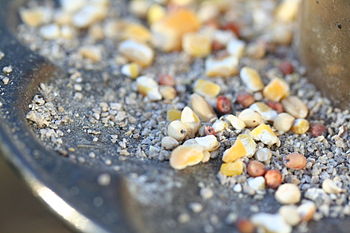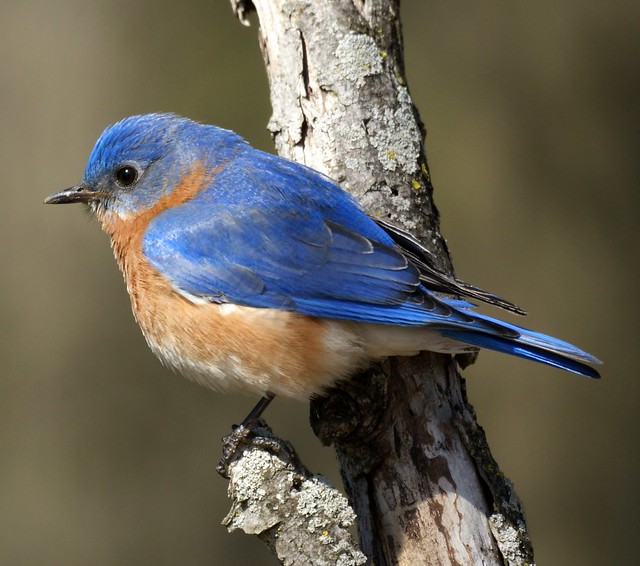 |
| Photo by budi javas (cc) |
Good hygiene and healthy nutrition are the basic requirements for a healthy parrot but being aware of the more common types of parrot disease will be useful in being a proactive pet owner. A prompt visit to the vet is recommended as well.
Pacheco's disease (PDV) is visible through symptoms such as lethargy, diarrhea, ruffled feathers, sinusitis, anorexia, conjunctivitis, and tremors in the neck, wing, and legs. The bird's fecal material may become discolored with urates becoming green suggesting possible liver damage.
Birds generally die from massive liver necrosis characterized by an enlarged liver, spleen, and kidneys. However, some birds die suddenly with no specific or observable symptoms.
Infected birds can start shedding the virus in the feces and nasal discharge as early as 3-7 days after infection. This viral disease is classified as highly contagious.
Pacheco's disease is often fatal and affects parrots of all ages. New World parrots are seen as more susceptible to PDV than Old World psittacines. Asymptomatic birds can be carriers of Pacheco's virus. Birds that have survived an outbreak of PDV can be possible carriers.
PDV appears to be reactivated when the parrot is under stress during times such as breeding, loss of a mate, or other environmental changes.
Avian Chlamydia, also known as Psittacosis, Parrot Fever or chlamydiosis is when parrots are infected by intracellular parasites. These are sometimes called energy parasites because they use ATP (a crucial energy containing metabolite) produced by the host cell.
Dull plumage, drop in body temperature, lethargy, conjunctivitis and yellow to greenish droppings or grayish watery droppings are among the symptoms. Sometimes there is no outward evidence of an infection.
This is an airborne bacterial disease. The bacteria can be shed by an infected bird through its bodily secretions, fecal material, and feather dust. The organism may remain relatively stable outside the host body and can dry into a dusty substance and contaminate the air.
Incubation periods in caged birds vary from days to months although most often this is 3 to 10 days. The incubation period is hard to gauge because chronically infected birds sometimes develop persistent and asymptomatic infections.
Parrots in overcrowded settings are particularly susceptible to the disease. A significant detail about Avian Chlamydia is that it is a zoonotic disease which can be transmitted from animals to humans.
Psittacine Beak and Feather Disease (PBFD) is the disease in which we see a loss of feathers, development of abnormal feathers, new pinched feathers, shedding of developing feathers and loss of powder down.
Overgrown or abnormal beak, symmetrical lesions on the beak and occasionally nails are other likely signs. Immunosuppression, dramatic weight loss, and depression are also seen as the disease progresses.
PBFD is caused by a virus that also sometimes affects the liver, brain, and immune system. Secondary infections stemming from this sometimes lead to complications and death.
Transmission is through direct contact and the infected environment has to be thoroughly cleaned as the viral particles can persist in the environment even after the infected bird is removed.
PBFD is supposed to be specific to psittacines and some species that are particularly vulnerable to it are Cockatoos, Macaws African Grey Parrots, Ringneck parakeets, Eclectus Parrots, and Lovebirds.
PBFD can be fatal for young birds and even adult birds that survive can become carriers. Others feel that those survivors develop an immunity which can be genetically transferred to their offspring.
Feather Plucking can be a traumatic problem for the parrot and the pet owner as it seems to indicate more deep-rooted problems. The broad reasons for feather plucking are improper diet or inadequate nutrition, emotional stress and bacterial or fungal infection.
Owners should ensure that the bird is not kept in too small a cage and if the bird is molting special nutritional attention should be paid. Also keep an eye open for fleas, lice or ticks. While these are rare they can be the cause of skin irritation also.
A well-balanced diet, a mentally stimulating environment, adequate physical space and good hygiene are among things that can help with this problem.
Escherichia coli (E. coli) are manifested as ruffled feathers, diarrhea, listlessness, and shivering. Baby birds, with less developed immune systems, are more susceptible to disease.
Chronic infections in adult birds can lead to abscesses, failure to hatch eggs and cause changes in eating habits. The extent to which a bird is affected will depend on the age and immune system of the bird and on the potency of the bacteria.
Clean feeding bowls and water and antibiotics can help most birds recover fully from the infection of common parrot-disease.
|




